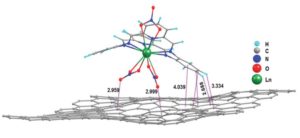Scientists in India have made graphene field-effect transistors that work for over 10 months with some help from discrete inorganic structures. The approach has led them to produce a graphene logic inverter that is stable in ambient conditions.
Conventional electronics tend to be silicon based, due to the ease of doping silicon with either electrons or holes. These two forms of silicon, n- and p-type, are the building blocks of electronic devices. However, it isn’t possible to make silicon electronics on the nanoscale, so many researchers are turning to materials like graphene.
An essential component of digital electronics is a logic inverter – a device for switching between fixed voltage levels. Inverters combine n-type field effect transistors and p-type field effect transistors, so require both n-type and p-type graphene.

Source: © Maheswaran Shanmugam/Indian Institute of Technolgy Bombay
The lanthanide-macrocyclic complexes exhibit strong C-H–π interactions with graphene, leading to a sharp and stable negative shift in the Dirac point
To read the full article visit Chemistry World.
Lanthanide complexes as molecular dopants for realizing air-stable n-type graphene logic inverters with symmetric transconductance
Ashwini S. Gajarushi, Mohd Wasim, Rizwan Nabi, Srinivasu Kancharlapalli, V. Ramgopal Rao, Gopalan Rajaraman, Chandramouli Subramaniam and Maheswaran Shanmugam
Mater. Horiz., 2019, Advance Article
http://dx.doi.org/10.1039/C8MH01241E










